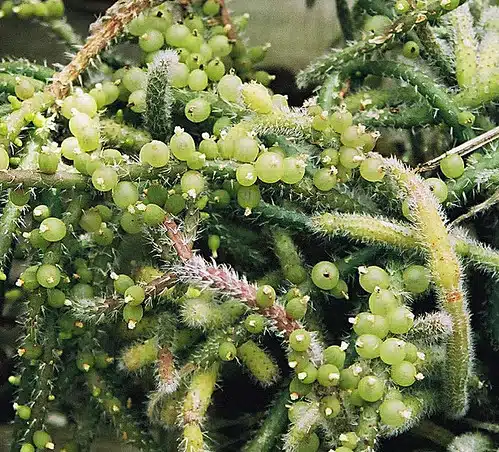As plant enthusiasts continue to explore the world of indoor gardening, the Rhipsalis cactus has become a popular choice due to its unique and stunning appearance, ease of care, and ability to thrive in low-light conditions. This epiphytic cactus is native to Central and South America and belongs to the Cactaceae family. With over 60 different species, the Rhipsalis cactus is a versatile addition to any indoor garden.
In this article, we will discuss everything you need to know about caring for your Rhipsalis cactus, including its ideal growing conditions, watering requirements, fertilization needs, propagation methods, and common pests and diseases. Whether you are a seasoned gardener or just starting out with houseplants, this guide will provide valuable information that will help you successfully grow and maintain a healthy Rhipsalis cactus in your home.
Overview Of Rhipsalis Cactus
As you walk through a tropical forest, the sight of Rhipsalis Cactus hanging from trees is a common occurrence. These epiphytic cacti are native to Central and South America and can also be found in parts of Africa. The genus Rhipsalis belongs to the cactus family, Cactaceae, and is known for its unique appearance and ease of care.
There are over 60 species of Rhipsalis Cactus with varying shapes and sizes. Some have thin, cylindrical stems that hang down like hair, while others have flattened or segmented stems that resemble leaves. Most varieties produce small white or yellow flowers that bloom in the spring or summer. One notable species is the mistletoe cactus (Rhipsalis baccifera), which produces bright red berries around Christmas time.
As indoor plants, Rhipsalis Cacti are popular due to their low maintenance requirements and ability to thrive in low light conditions. They make great additions to any home or office space as they add a touch of greenery without taking up much space. Understanding the different varieties and origins of this plant can help you provide it with proper care to ensure it thrives in your environment. To better understand how to care for Rhipsalis Cacti, it’s essential first to gain an understanding of the broader cacti family.
Understanding The Cactaceae Family
Cacti are fascinating plants with a unique set of characteristics that distinguish them from other succulents. The Cactaceae family is comprised of around 175 genera and over 2,000 species, making it one of the most diverse plant families in the world. These plants come in many shapes and sizes, ranging from small, round cacti to large, columnar ones.
Cactus classification is based on several factors such as the presence or absence of leaves, stem morphology, flower structure, and habitat. For example, some cacti have flattened stems that resemble leaves while others have cylindrical stems that store water. The majority of cacti produce showy flowers that are often pollinated by insects or birds.
The evolution of cacti has been an area of interest for botanists and paleontologists alike. It is believed that cacti originated in the Americas during the late Cretaceous period and spread to other parts of the world through seed dispersal mechanisms. Over time, they developed adaptations for survival in arid environments such as thickened stems for water storage and modified leaves for photosynthesis. Understanding the evolution of these plants can shed light on their current distribution and ecological role in different regions around the world.
Moving forward into understanding how to care for rhipsalis cactus requires knowing its environmental needs.
Environmental Needs Of Rhipsalis Cactus
- Rhipsalis cactus is an ideal houseplant due to its low-maintenance requirements, but an understanding of its environmental needs is still necessary for successful cultivation.
- Temperature should be kept between 65-80°F during the day and no lower than 55°F at night.
- Humidity should be between 40-60%, and Rhipsalis cactus should be placed in a sunny location that is free of direct sunlight.
- Soil should be well-draining and amended with peat moss and perlite, and watering should be done when the top inch of soil becomes dry.
Temperature
To keep your Rhipsalis cactus healthy, it is important to provide it with the ideal temperature. These plants thrive in moderate temperatures and can tolerate a wide range of temperatures between 15°C to 30°C. However, they prefer temperatures between 18°C to 24°C during the day and slightly cooler temperatures at night. It is essential to avoid extreme temperature fluctuations as this can cause stress on the plant and affect its growth.
Temperature control techniques can be employed to maintain the ideal temperature for your Rhipsalis cactus. During warmer months, ensure that the plant is not exposed to direct sunlight as this can lead to overheating. Consider placing it in a cooler spot or providing shade using curtains or blinds. In colder months, it is crucial to protect the plant from frost by keeping it away from cold drafts or windows that may cause chilling injury.
In conclusion, providing your Rhipsalis cactus with the ideal temperature is necessary for its growth and overall health. By employing temperature control techniques, you can maintain moderate temperatures suitable for your plant’s needs. Remember to monitor any changes in room temperature and adjust accordingly to avoid exposing your cactus plant to extreme temperatures that may cause harm.
Humidity
Maintaining the ideal environmental conditions for your Rhipsalis cactus is essential for its health and growth. Apart from temperature, humidity level is another crucial factor that must be considered. These plants are native to tropical regions with high humidity levels, so it is vital to provide them with a similar environment indoors. Low humidity can lead to dryness in the plant’s soil, causing it to wilt and eventually die.
To maintain the optimal humidity level for your Rhipsalis cactus, consider placing a tray of water near the plant or using a humidifier. This will help increase the moisture content in the air around the plant and prevent it from drying out. Additionally, proper air circulation is crucial as stagnant air can lead to high humidity levels, promoting fungal growth and diseases that can harm your plant.
In conclusion, maintaining an optimal humidity level for your Rhipsalis cactus is necessary for its health and survival. By providing adequate moisture content in the air through proper ventilation or using a humidifier, you ensure that your plant thrives in an environment similar to its natural habitat. Remember to monitor any changes in humidity levels and adjust accordingly to prevent any adverse effects on your plant’s growth.
Choosing The Right Pot And Soil
As a horticulturalist, I would like to stress the importance of choosing the right pot and soil for your rhipsalis cactus. Think of it as selecting the perfect bed for a good night’s sleep. A pot that is too small will make it difficult for the roots to grow, while one that is too big may retain excess moisture leading to root rot. The ideal pot size should be about two inches larger in diameter than the root ball.
Soil type is just as important as pot size. Rhipsalis cacti thrive in well-draining soil that allows air to circulate freely around the roots. Avoid using heavy garden soil or compost with high water retention capacity, which can suffocate or damage the roots. Instead, opt for a cactus mix that contains perlite or sand to ensure good drainage.
Remember that choosing the right pot and soil combination will create an environment where your rhipsalis cactus can flourish. In order to ensure optimal growth, consider repotting your plant every two years and refreshing its soil at least annually. But before we move on to watering your rhipsalis cactus, let’s discuss some helpful tips on how to choose just the right amount of water for your plant’s needs.
Watering Your Rhipsalis Cactus
Watering your Rhipsalis cactus can be a bit tricky, but with the right knowledge, you can ensure that your plant thrives. These plants are native to tropical rainforests, so they prefer a moist environment, but overwatering can lead to root rot and other issues. The frequency of watering will depend on several factors such as the climate, humidity levels, and potting medium.
To determine when your Rhipsalis cactus needs water, it’s important to check the soil moisture level regularly. Stick your finger about an inch into the soil; if it feels dry, it’s time to water. During the growing season (spring and summer), you may need to water every one or two weeks. In the winter months, you can reduce watering to once every three weeks or so. Overwatering can cause leaves to turn yellow and fall off or lead to fungal problems in the soil.
Signs of overwatering include brown spots on leaves or a mushy stem near the base of the plant. If you notice these signs, cut back on watering immediately and allow the soil to dry out completely before watering again. It’s also important to make sure that your pot has good drainage; excess water should be able to drain away from the roots easily. By following these guidelines for watering your Rhipsalis cactus appropriately, you’ll help ensure its longevity and health.
Moving onto fertilizing your Rhipsalis cactus, it’s important to provide adequate nutrients for healthy growth. The next section will cover some tips for choosing the right fertilizer and timing for application.
Fertilizing Your Rhipsalis Cactus
There are several types of fertilizer that can be used to nourish a Rhipsalis Cactus, such as organic compost, slow-release pellets, and liquid fertilizer. Fertilizing should be done during the active growing season, generally in the spring and summer, and at half the recommended rate as indicated on the fertilizer package. When fertilizing, it is important to avoid contact with the stem or leaves of the cactus, as this may cause irritation or damage to the plant. Additionally, it is crucial to water the plant thoroughly before and after fertilizing to wash away any excess fertilizer that may have settled on the plant. Finally, after fertilizing, it is important to monitor the plant for any signs of distress or discoloration and adjust the fertilizer application as needed.
Types Of Fertilizer
Fertilizing your Rhipsalis Cactus is an important aspect of its overall care. When it comes to choosing the right type of fertilizer, you have two options: organic or chemical. Organic fertilizers are derived from natural sources and contain nutrients like nitrogen, phosphorus, and potassium. On the other hand, chemical fertilizers are synthetically made and provide a more concentrated dose of nutrients.
Organic fertilizers are a great choice for those who want to keep their Rhipsalis Cactus as natural as possible. They slowly release nutrients over time, which helps prevent over-fertilization and potential damage to the plant. These types of fertilizers can be applied every 4-6 weeks during the growing season. Common organic options include compost tea, fish emulsion, and bone meal.
Chemical fertilizers are a more convenient option for those who want a quick and easy way to feed their plants. However, they should be used with caution as they can easily burn your Rhipsalis Cactus if applied too frequently or in large amounts. Chemical fertilizers can be applied every 2-4 weeks during the growing season. Look for a balanced formula that contains equal amounts of nitrogen, phosphorus, and potassium for optimal results.
Frequency Of Fertilizing
As a responsible plant owner, it is essential to establish a fertilizing schedule that is appropriate for your Rhipsalis Cactus. Fertilizing your cactus is crucial in ensuring its healthy growth and nourishment. A well-fed plant has improved resistance against pests and diseases. A balanced fertilizing regimen can also result in more blooms during the flowering season.
When it comes to the frequency of fertilizing, it is best to take into account the type of fertilizer you are using. Organic fertilizers release nutrients slowly over time, which means they do not need to be applied as frequently as chemical fertilizers. Applying organic fertilizers every 4-6 weeks during the growing season should suffice, depending on the specific needs of your Rhipsalis Cactus.
It is crucial to remember that over-fertilization can harm your plant’s health. Applying too much fertilizer or doing so too often can cause damage to its roots and leaves. Therefore, it is vital to follow a consistent schedule when applying any type of fertilizer. By following these guidelines, you can ensure that your Rhipsalis Cactus receives adequate nourishment while keeping it healthy and thriving for years to come.
Precautions When Fertilizing
It is important to note that while fertilizing your Rhipsalis Cactus is crucial for its growth and nourishment, it should be done with caution. Fertilizer toxicity can harm your plant’s health, causing damage to its roots and leaves. Over-fertilization or using the wrong type of fertilizer can lead to this harmful situation.
Organic fertilizers are a safer option than chemical fertilizers when it comes to avoiding over-fertilization. They release nutrients slowly, reducing the risk of toxicity in your plant. When applying organic fertilizers, you must follow a consistent schedule and take into account the specific needs of your Rhipsalis Cactus.
Another precaution when fertilizing is to avoid applying fertilizer to dry soil or a dehydrated plant. Your Rhipsalis Cactus must be well-watered before applying any fertilizer to prevent root damage or burning of the leaves. Additionally, you should avoid direct contact between the fertilizer and your skin as some types may cause irritation or allergic reactions. By following these precautions, you can ensure that your Rhipsalis Cactus receives adequate nourishment while keeping it healthy and thriving for years to come.
Propagating Rhipsalis Cactus
Propagation is an important aspect of growing Rhipsalis cactus plants. It allows you to expand your collection and share the beauty of this plant with others. There are two main methods for propagating Rhipsalis cacti: water propagation and division propagation.
Water propagation involves taking a cutting from the parent plant and placing it in a container of water until roots develop. The cutting should be taken from healthy growth and should be at least 3-4 inches long. Once roots have formed, the new plant can be transplanted into soil.
Division propagation involves separating offsets or pups from the parent plant. This method is best done during repotting when the root system can be easily accessed. Gently separate the offsets from the parent plant, making sure to keep some roots attached to each one. Then, transplant them into their own pots with fresh soil.
Both methods of propagation can be successful if done correctly. It is important to provide proper care for these new plants as they establish themselves in their new environment. With time and patience, you can enjoy a beautiful collection of Rhipsalis cacti in your home or garden.
As you continue to care for your Rhipsalis cactus plants, pruning and maintenance will become necessary. In order to encourage healthy growth, it is important to remove any dead or damaged parts of the plant as soon as possible. Regularly inspecting your plants for signs of pests or disease can also help prevent further damage. Additionally, providing proper lighting, water, and fertilizer will ensure that your Rhipsalis cacti thrive in their environment.
Pruning And Maintenance
Now that you have successfully propagated your Rhipsalis cactus, it’s time to shift focus on maintaining its growth and appearance. Pruning is a crucial aspect of plant care that should not be overlooked. Not only does it improve the plant’s overall structure and shape, but it also promotes healthy growth.
One of the benefits of pruning is that it helps remove dead or damaged leaves, which can attract pests and diseases that may harm your plant. Additionally, pruning helps to control the size of your Rhipsalis cactus as it can quickly grow out of control if left unattended. It’s best to prune during the spring or summer months when the plant is actively growing.
To ensure proper maintenance of your Rhipsalis cactus, invest in some essential tools such as sharp pruning shears or scissors. These will help make clean cuts without damaging any healthy parts of the plant. Aside from pruning, general maintenance practices like regular watering and fertilization are important for keeping your cactus healthy and thriving.
As with any indoor plant, common pests and diseases can still affect your Rhipsalis cactus despite proper maintenance practices. In the next section, we’ll discuss some common pests and diseases that may afflict this species and how to treat them effectively.
Common Pests And Diseases
When it comes to caring for rhipsalis cacti, one of the most important things to keep in mind is the potential for pests and diseases. While these plants are generally hardy, they can still be susceptible to certain issues that can damage their health and appearance.
One of the most common pests that affect rhipsalis cacti is spider mites. These tiny arachnids can quickly infest a plant and cause damage by sucking sap from the leaves. Symptoms of spider mite infestation include yellowing or speckling on the leaves, as well as webbing between branches. To combat this pest, there are several natural remedies available such as spraying the plant with neem oil or using a mixture of water and dish soap.
Another common issue that affects rhipsalis cacti is root rot, which occurs when soil-borne pathogens attack the roots of the plant. Symptoms of root rot include wilting or yellowing leaves along with a foul smell emanating from the soil. To prevent root rot, it’s important to ensure that your plant is not overwatered and has adequate drainage.
In summary, pests and diseases can pose significant threats to your rhipsalis cactus if not properly addressed. By learning about common symptoms and natural remedies like neem oil or dish soap solutions for spider mites and avoiding overwatering the plant to prevent root rot, you can help ensure your plant stays healthy and vibrant for years to come. In the next section, we’ll explore some preventative measures you can take to avoid pest infestations altogether.
Preventing Pest Infestations
- Identifying potential pests is essential for preventing an infestation, as it helps to determine the best methods for controlling them.
- Common pests of the Rhipsalis cactus include mealybugs, scale insects, and spider mites.
- Infestations can be prevented by regularly inspecting plants for signs of pests, maintaining adequate humidity and temperature levels, and avoiding overcrowding of plants.
- Additionally, proper hygiene within the home or greenhouse, such as regularly cleaning surfaces and removing debris, can help to minimize the risk of a pest infestation.
Identifying Potential Pests
Pests can be a real nightmare for any plant lover, especially when it comes to indoor plants. The rhipsalis cactus is no exception, and identifying potential pests is essential for preventing infestations. From spider mites to mealybugs, these tiny creatures can quickly multiply and damage your precious plant. As a horticulturalist, my advice would be to keep an eye out for any signs of infestation on your rhipsalis cactus.
One way to identify pests is by checking the leaves and stems for unusual markings or discoloration. Spider mites often leave small yellow spots on the leaves, while mealybugs create white cotton-like webs on the stems. Another sign of pest infestation is sticky residue on the leaves or soil caused by aphids or scale insects. These pests are known to suck sap from the plant, weakening it over time. If you notice any of these signs, it’s crucial to take action immediately.
Preventing pest infestations doesn’t always require chemical treatments; there are natural remedies that you can use as well. For example, neem oil is a popular natural insecticide that targets a range of pests without harming beneficial insects like bees and ladybugs. Another option is diatomaceous earth, which works by dehydrating insects and disrupting their exoskeletons. However, if the infestation is severe, chemical treatments may be necessary. It’s important to follow instructions carefully when using any pesticide and avoid over-applying them as they can harm your plant’s health.
In conclusion, identifying potential pests early on is key to preventing infestations in your rhipsalis cactus. By keeping an eye out for signs of damage and using natural remedies or chemical treatments when necessary, you can ensure that your plant stays healthy and happy all year round. Remember to always follow proper care guidelines for your indoor plants and consult with a professional if you’re unsure about how to deal with a pest problem.
Preventing Infestations
Preventing pest infestations is a crucial part of caring for indoor plants, including the rhipsalis cactus. Not only can pests damage your plant’s health, but they can also spread to other plants and cause an even bigger problem. Fortunately, there are several ways to prevent infestations from occurring in the first place.
One effective method of preventing pest infestations is by using natural remedies. These remedies work by targeting pests without harming beneficial insects or your plant’s health. For example, essential oils like neem oil or peppermint oil can be used as insecticides. Additionally, introducing beneficial insects like ladybugs or lacewings can help control pests naturally.
Another way to prevent infestations is through proper plant care practices. Healthy plants are less susceptible to pest problems than unhealthy ones. Ensure that your rhipsalis cactus receives adequate sunlight, water, and nutrients. Overwatering or underwatering can weaken your plant and create conditions that attract pests.
While natural remedies and proper plant care practices are effective in preventing pest infestations, sometimes chemical treatments may be necessary. However, it’s important to use them as a last resort and follow instructions carefully to avoid harming your plant or the environment. By taking proactive steps towards preventing pest infestations, you’ll be able to keep your rhipsalis cactus healthy and thriving for years to come.
Treating Pest Infestations
Preventing Pest Infestations is crucial in maintaining a healthy rhipsalis cactus. However, there may be instances where despite proper care and management, pests still infest the plant. In such cases, it is important to address the problem immediately to prevent further damage. This section will discuss the different treatments that can be used for pest infestations.
When dealing with pest infestations, natural remedies are always the first option. These remedies are effective and safe for your plant and the environment. One example is neem oil, which is a natural insecticide that can control various pests such as spider mites and mealybugs. Another remedy is using soapy water, wherein you mix mild dish soap with water and spray it onto the affected area. This method suffocates insects like aphids and whiteflies.
If natural remedies prove to be ineffective, chemical treatments may be necessary. However, these treatments should only be used as a last resort since they can harm not just the pests but also beneficial insects and microorganisms in your soil. Furthermore, these chemicals can pose health risks to humans and pets if not used properly. It’s essential to read labels carefully before applying any chemical treatment.
In conclusion, addressing pest infestations promptly is crucial in preventing further damage to your rhipsalis cactus plant. Natural remedies should always be tried first before resorting to chemical treatments due to their negative impact on non-target organisms and potential health risks. By being vigilant in monitoring your plants’ health regularly and taking necessary actions at an early stage of infestation, you can safeguard your beloved indoor plants from harm.
Transition sentence: After learning about treating pest infestations effectively, let us now focus on how we can prevent disease outbreaks from affecting our rhipsalis cactus plants through proper maintenance procedures.
Preventing Disease Outbreaks
Sanitation practices are essential in preventing disease outbreaks in rhipsalis cacti. Regularly cleaning the plant and its surroundings can help to remove any potential sources of infection, such as dead leaves or debris. It is advisable to use a solution of water and mild soap to clean the plant thoroughly, making sure to rinse it well afterward.
Using natural remedies is another effective way to prevent disease outbreaks in rhipsalis cacti. One such remedy is neem oil, which has been proven to have antifungal and antibacterial properties. Applying neem oil on the plant can help to control common fungal diseases such as powdery mildew. Additionally, spraying a solution of apple cider vinegar mixed with water on the leaves can also help to prevent fungal growth.
Preventing disease outbreaks in rhipsalis cacti requires a proactive approach that involves regular sanitation practices and the use of natural remedies. By keeping the plant clean, removing any potential sources of infection, and using natural remedies like neem oil and apple cider vinegar solutions, you can help keep your rhipsalis cactus healthy and thriving for years to come.
To continue maintaining your rhipsalis cactus’s health, it is important to know how to treat disease outbreaks effectively. When faced with disease outbreaks, prompt action must be taken before it spreads and causes irreversible damage. In the next section, we will discuss effective ways of treating disease outbreaks in rhipsalis cacti without causing harm to the plant’s overall health.
Treating Disease Outbreaks
Although preventing disease outbreaks is essential, sometimes they can still occur despite our best efforts. When it comes to caring for rhipsalis cactus, it’s crucial to act quickly if you notice any signs of disease. Catching the problem early on will help increase the chances of saving your plant.
One option for treating disease outbreaks is to use natural remedies. These can be effective and are often less harmful to the plant than chemical treatments. For instance, neem oil is a natural fungicide that can be used to treat fungal infections. Additionally, a mixture of water and dish soap can be used to combat pests like spider mites.
However, in some cases, chemical treatments may be necessary to save your rhipsalis cactus from disease. It’s important to choose a treatment that is specifically designed for the type of disease affecting your plant and follow the instructions carefully. Remember to wear protective gear when applying chemicals and keep pets and children away from treated areas until it’s safe.
Moving forward with troubleshooting tips, there are several things you can do to prevent future disease outbreaks in your rhipsalis cactus. One important step is to ensure that your plant has proper drainage and isn’t sitting in water for extended periods. Additionally, avoid over-fertilizing or over-watering as this can weaken the plant’s immunity system. Finally, regularly inspect your plants for any signs of problems so that you can address them quickly before they become major issues.
Troubleshooting Tips
Like any other houseplant, rhipsalis cactus requires careful attention and proper care to thrive. However, even the most experienced plant owners may encounter a few difficulties when caring for their rhipsalis cactus. Therefore, it is essential to know some common mistakes and their prevention measures.
One of the most common mistakes that plant owners make is overwatering their rhipsalis cactus. This can lead to root rot, which can be fatal for the plant. To prevent this from happening, ensure that the soil is dry before watering your plant. Additionally, avoid using pots without drainage holes as they tend to retain excess water.
Another mistake that plant owners often make is exposing their rhipsalis cactus to direct sunlight for prolonged periods. While these plants require bright light, intense sunlight can harm them by causing sunburns or heat stress. To prevent this issue from occurring, place your rhipsalis cactus in a spot where it receives indirect sunlight or partial shade.
In conclusion, taking care of a rhipsalis cactus requires patience and attention to detail. By avoiding common mistakes such as overwatering and excessive exposure to sunlight, you can help your plant thrive and grow healthily. In the next section, we will provide final thoughts on how to maintain and care for your rhipsalis cactus effectively.
Conclusion And Final Thoughts
Now that we have gone over some common troubleshooting tips for Rhipsalis cactus care, let’s discuss how to display and repot this unique indoor plant. When it comes to displaying your Rhipsalis cactus, you can get creative with different types of containers, such as hanging baskets or terrariums. Just make sure the container has proper drainage and enough space for the roots to grow.
Repotting your Rhipsalis cactus should be done every two to three years, or when you notice its roots outgrowing its current container. It’s essential to use well-draining soil and a pot that is only slightly larger than the current one. When repotting, be gentle with the root system and avoid damaging any of the delicate stems.
Finally, let’s talk about transplanting your Rhipsalis cactus. If you want to move it outside during warmer months or into a larger pot permanently, it’s important to do so gradually to avoid shock. Start by placing the plant in a shady area for a few hours each day and gradually increase its exposure to sunlight over several weeks. Transplanting should only be done during spring or early summer when the plant is actively growing.
As with any plant care routine, there are common mistakes that can be avoided when caring for Rhipsalis cactus. Overwatering is one of the most common mistakes, so make sure not to water too frequently and allow the soil to dry out between waterings. Similarly, avoid placing your Rhipsalis cactus in direct sunlight or near heat sources as this can cause damage to the delicate stems.
Overall, Rhipsalis cactus can make an excellent addition to any indoor plant collection with proper care and attention. By following these tips for displaying, repotting, and transplanting while avoiding common mistakes, you can enjoy a healthy and thriving Rhipsalis cactus in your home or office.
Frequently Asked Questions
Can Rhipsalis Cactus Be Grown Outdoors?
When it comes to outdoor growth, climate adaptability is key. Just like humans, plants have their own unique preferences for temperature, humidity, and sunlight. Some plants thrive in the heat of the desert while others prefer the coolness of a rainforest. The Rhipsalis cactus is a prime example of a plant that has adapted well to different climates. While it is often grown as an indoor plant, the Rhipsalis cactus can also be grown outdoors in certain conditions. It is important to note that this plant does best in areas with mild temperatures and high humidity levels. In fact, some varieties of Rhipsalis cacti are native to tropical rainforests where they grow under the shade of larger trees. If you live in an area with a similar climate, then your Rhipsalis cactus may thrive outdoors just as it does indoors.
How Often Should Rhipsalis Cactus Be Repotted?
In order to maintain the health and vitality of a rhipsalis cactus, it is important to repot the plant when it has outgrown its current container. The frequency at which this should occur depends on several factors, including the size of the pot, the growth rate of the plant, and the soil mix being used. As a general rule, rhipsalis cacti should be repotted every two to three years. When repotting, it is crucial to use a well-draining soil mix that allows for adequate airflow around the roots. This can be achieved by mixing together equal parts of peat moss, perlite, and coarse sand. By following these guidelines for repotting frequency and soil mix, gardeners can ensure that their rhipsalis cacti remain healthy and vibrant for years to come.
Is Rhipsalis Cactus Toxic To Pets?
Pet safety is always a concern for pet owners, especially when it comes to indoor plants. As a horticulturalist or plant care specialist, it is important to be aware of any toxicity concerns regarding the plants we recommend to our clients. Some plants can cause mild irritation, while others can be potentially fatal if ingested by pets. Therefore, before recommending any houseplant, it is crucial to research its potential effects on pets and share that information with clients. In the case of Rhipsalis Cactus, it has been reported as non-toxic to both cats and dogs according to the ASPCA. However, it is still important to keep an eye on pets around the plant and discourage them from chewing on any part of the cactus or soil as this could still lead to gastrointestinal upset.
How Long Does It Take For Rhipsalis Cactus To Flower?
In the world of horticulture, flowering season and growth rate are two significant factors that plant enthusiasts often consider in cultivating their plants. For instance, a hypothetical scenario is that a gardener would like to grow a Rhipsalis Cactus and wonders how long it will take for it to bear flowers. As an expert in plant care, it is essential to note that Rhipsalis Cacti bloom during late winter or early spring, depending on the species. However, the flowering period may also vary due to environmental factors such as light exposure and temperature. In terms of growth rate, Rhipsalis Cacti generally have moderate growth rates and can take years before they produce flowers. Nevertheless, with proper care and attention, these cacti can thrive indoors and even bloom annually during their flowering season.
Can Rhipsalis Cactus Tolerate Direct Sunlight?
When considering sunlight exposure for any indoor plant, it is important to understand the ideal conditions for that particular species. Rhipsalis cactus, for example, can tolerate some direct sunlight but prefers bright, indirect light. Direct sunlight can cause damage to the leaves and may stunt growth. It is recommended to place the plant near a window with filtered light or in a room with bright artificial lighting. Additionally, it is important to monitor the temperature around the plant as high temperatures combined with direct sunlight can lead to dehydration and leaf damage. Overall, providing ideal growing conditions including proper lighting will ensure the health and vitality of any indoor plant.
Conclusion
The Rhipsalis cactus, a unique and captivating plant, can be grown indoors or outdoors. Although it is commonly thought of as a houseplant due to its tropical origins, it can also thrive in warm and humid outdoor climates. When repotting this cactus, it is important to do so every two to three years, ensuring that the soil is well-draining and the pot has adequate drainage holes. It should also be noted that while the Rhipsalis cactus is not toxic to pets, it is best to keep any plant out of reach of curious animals.
While the Rhipsalis cactus does flower, the process can take several years to occur. However, with proper care such as regular watering and fertilization during its growing season, this unique plant will eventually produce showy white or pink blooms. It should also be noted that while the Rhipsalis cactus thrives in bright indirect light, direct sunlight can damage its delicate foliage.
In conclusion, growing and caring for a Rhipsalis cactus requires patience and attention to detail. As with any living organism, understanding its needs and providing optimal conditions for growth are crucial factors in achieving success. So whether you choose to keep this captivating plant inside your home or outside on your patio, with proper care and attention, the Rhipsalis cactus will continue to thrive and bring joy for years to come.
Image Credits
- “Rhipsalis baccifera, the Mistletoe Cactus” by Dick Culbert (featured)





























